Abstract
In the first part of this study, acrylic acid (AA) hydrogels were produced by a free radical reaction. Chemical and morphological structures of AA-hydrogels were specified by using Fourier transform infrared (FT-IR) spectroscopy and scanning electron microscopy (SEM) techniques. In the second part of the study, ZnO nanoflowers were synthesized on the AA-hydrogel by using a chemical bath deposition (CBD) technique for the first time in the literature. The AA-hydrogel acted as the substrate in the CBD process. The deposition time effect on the morphological properties of ZnO nanoflowers was determined by applying SEM. According to the SEM results, the deposition time in the production of ZnO nanoflowers has played a vital role in the surface morphology. Chemical, morphological and thermal properties of the ZnO nanoflowers were determined by applying FT-IR, scanning electron microscopy-energy dispersive X-ray spectroscopy and thermogravimetric analysis techniques. Elemental mapping of ZnO nanostructures was carried out using SEM. The antibacterial activity of the ZnO nanoflower-deposited AA-hydrogel was determined against Gram-negative and Gram-positive bacteria. Escherichia coli (E. coli) and Staphylococcus aureus (S. aureus) were used as test microorganisms. Gram-negative bacteria were more resistant to hydrogels and ZnO nanoflowers compared to Gram-positive bacteria.





Similar content being viewed by others
References
Matei A, Cernica I, Cadar O, Roman C and Schiopu V 2008 Int. J. Mater. Form. 1 767
Priyanka G, Brian P, David W B, Wenjie H, William P J and Anne J A 2009 J. Biol. Eng. 3 1
Emami-Karvani Z and Chehrazi P 2011 Afr. J. Microbiol. Res. 5 1368
Rai M, Yadav A and Gade A 2009 Biotechnol. Adv. 27 76
Rizwan W, Young-Soon K, Amrita M, Soon-Il Y and Hyung-Shik S 2010 J. Nanoscale Res. Lett. 5 1675
Sawai J and Yoshikawa T 2003 J. Microbiol. Methods 54 177
Roselli M, Finamore A, Garaguso I, Britti M S and Mengheri E 2003 J. Nutr. 133 4077
Mohsen J and Zahra B 2008 Afr. J. Biotechnol. 7 4926
Laura K A, Delina Y L and Pedro J J A 2006 J. Water Resour. 40 3527
Sobha K, Surendranath K, Meena V, Jwala K T, Swetha N and Latha K S M 2010 J. Biotechnol. Mol. Biol. Rev. 5 1
Reddy K M, Kevin F, Jason B, Denise G W, Cory H and Alex P 2007 J. Appl. Phys. Lett. 90 1
Wahid F, Yin J J, Xue D D, Xue H, Lu Y S, Zhong C et al 2016 Int. J. Biol. Macromol. 88 273
Kalyani G, Anil V G, Bo-Jung C and Yong-Chien L 2006 J. Green Chem. 8 1034
Dobrucka R and Długaszewska J 2016 Saudi J. Biol. Sci. 23 517
Gunalan S, Sivaraj R and Rajendran V 2012 Prog. Nat. Sci.: Mater. Int. 22 693
Talebian N, Amininezhad S M and Doudi M 2013 J. Photochem. Photobiol. B 120 66
Karunakaran C, Rajeswari V and Gomathisankar P 2011 Mater. Sci. Semicond. Process. 14 133
Gokmen F O and Bayramgil N P 2017 Eur. Chem. Bull. 6 514
Temel S, Gokmen F O and Yaman E 2017 Eur. Sci. J. 13 28
Temel S, Gokmen F O and Yaman E 2017 Int. J. Curr. Adv. Res. 6 4646
Zhang L, Jiang Y, Ding Y, Daskalakis N, Jeuken L, Povey M et al 2010 J. Nanopart. Res. 12 1625
Dincă V, Mocanu A, Isopencu G, Busuioc C, Brajnicov S, Vlad A et al 2018 Arab. J. Chem. (in press)
Acknowledgements
This work was financially supported by the Scientific Research Project Commission of Bilecik Seyh Edebali University (Project Number is 2017-01.BŞEÜ.28-01). FT-IR and FESEM-EDX-Mapping measurements were performed in Bilecik Seyh Edebali University Central Research Laboratory. The antimicrobial activity tests were performed at Egemikal Environmental Health Laboratory. TG measurements were performed in Hacettepe University Advanced Technologies Application and Research Centre.
Author information
Authors and Affiliations
Corresponding author
Rights and permissions
About this article
Cite this article
Temel, S., Gokmen, F.O. & Yaman, E. Antibacterial activity of ZnO nanoflowers deposited on biodegradable acrylic acid hydrogel by chemical bath deposition. Bull Mater Sci 43, 18 (2020). https://doi.org/10.1007/s12034-019-1967-1
Received:
Accepted:
Published:
DOI: https://doi.org/10.1007/s12034-019-1967-1




